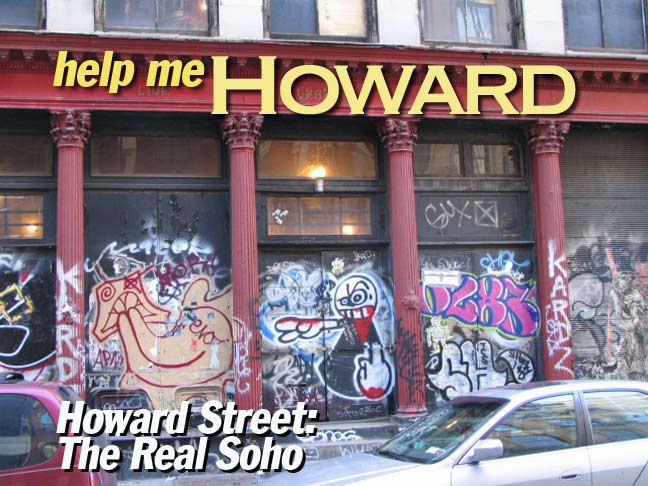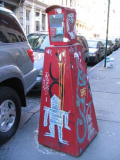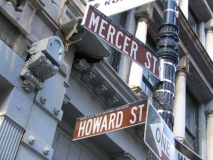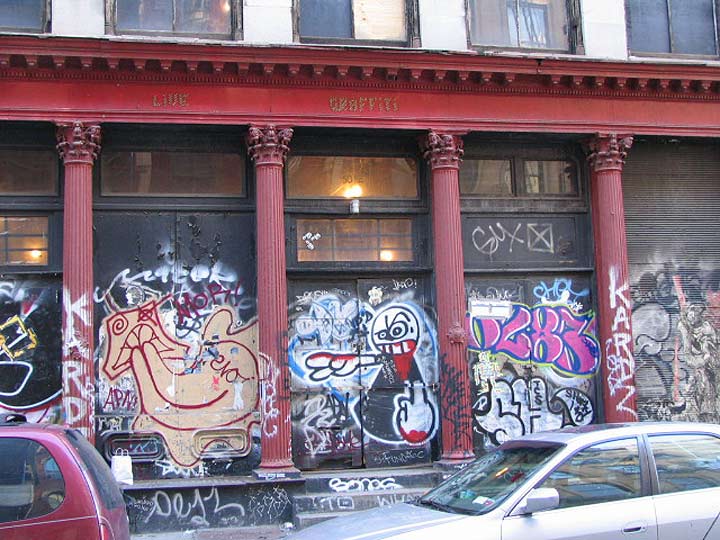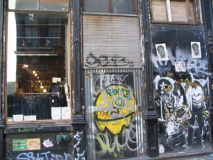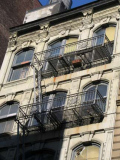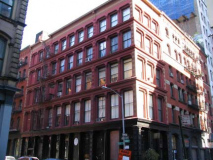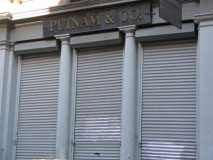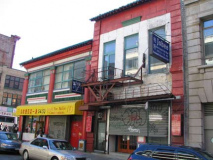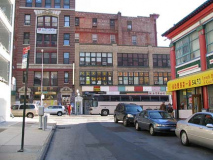Howard Street is something of an anomaly as far as Soho east-west cross streets go. It’s the shortest of them all, running only 4 blocks, from Mercer east to Lafayette just north of Canal. At its eastern end, it ventures into Chinatown’s northern edge. If you look at the map, it seems as if it should extend further west, but Canal Street’s skew northwest prevents it.
According to Sanna Fierstein in Naming New York, the street was named for Harry Howard (1822-1889), chief of NYC’s volunteer fire department in 1857-1860, before a citywide organization, the FDNY, was established. Among other things he established the practice of having sleeping quarters at stationhouses.
That assertion would seem to be off base, though, since older maps show the name had been acquired by the mid-1820s. Henry Moscow, in The Street Book, professes uncertainty about the origin of the name but asserts that the western end of Hester Street had been renamed Howard by 1820. The two streets do not run through these days, if they ever did.
Urban explorers come from all backgrounds and are interested in different kinds of detail. The decorative scrollwork on the cast-iron front at Mercer and Howard, as well as on the retro-Bishop Crook on the corner, attract my attention…
…as does the ‘temporary’ fire alarm on the corner. When a lamp, alarm or stoplight gets knocked over, the practice in NYC for many decades is to install a temporary one which, if you look at shots from years ago, are inevitably roughly pyramidical wooden items with a single metal pipe emerging out of the apex; the lamp or stoplight is afixed to that, and a couple weeks later, the DOT returns the original post or installs a new one. Rarely, though, have I seen such a pyramidal fire alarm; I have no idea how long this one has been here.
Other urban chroniclers see the space alien and can rattle off, with no hesitation, which ‘street artist’ wrote it there.
Anyone remember the ‘Easter egg’ in older editions of QuarkXPress, the page layout computer program? I think if you pressed a combination of three keys–I think it was command shift K–a space alien would slowly walk in from off the screen with a ray gun and zap whatever you had on the page. Your webmaster has been looking for Easter eggs in the streets of NYC for nearly 40 years.
Here’s a look at 50-52 Howard, just east of Mercer, without the titles on it. Streets in lower Manhattan are numbered from east to west, so the higher the house number, the further west you are. This doesn’t seem to make much sense tour webmaster since my Western eyes tend to read from left to right.
I’m not sure how safe the building is, or if it’s occupied at all. There’s a light on within, but there’s a boxed “X” indicating an unsafe floor. The first floor is overrun with graffiti, but renowned photographer Jay Maisel lives and works in a Bowery building similarly decorated on the ground floor, so the presence of graffiti doesn’t mean the absence of anything else. The building is over 145 years old.
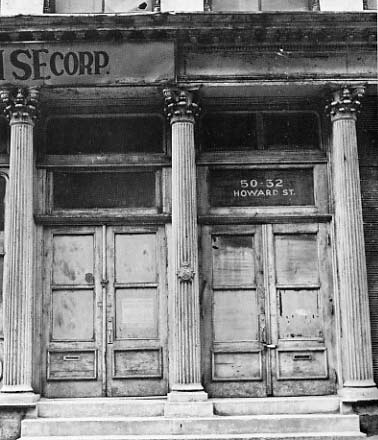 Soon after it was built in 1861 for arms merchant Adam W. Spies (that phrase is pejorative these days, but what else do you call a gun dealer) the building found use as the NY State Soldiers’ Depot, a rest home for Union soldiers on leave.
Soon after it was built in 1861 for arms merchant Adam W. Spies (that phrase is pejorative these days, but what else do you call a gun dealer) the building found use as the NY State Soldiers’ Depot, a rest home for Union soldiers on leave.
In light of what we know about it, we can readily people it with uniformed soldiers and lady volunteers in crinolines, and evoke a sense of its earlier importance. —Margot Gayle,Cast-Iron Architecture in New York
In the past the building has been home to woodworker William A. Stokes & Co., and Rivoli, notions wholesalers. The ironwork was produced by the J. L. Jackson Bros. foundry on Goerck Street (in the Lower east Side; that street has largely disappeared, replaced by the Baruch Houses)
You can glimpse the detail among and around the scribbled mess. I don’t know…you could throw a plate of scrambled eggs at it and get the same effect, but not the same permanence, I suppose. This is the Howard Street side of the massive former Arnold Constable Department Store that fronts on Canal and also faces Broadway. 1862.
RIGHT: Great escapes at 34 Howard, a building co-designed by James Renwick Jr.: he also built St. Patrick’s Cathedral, Roosevelt Island’s crumbling Smallpox Hospital, and other distinguished buildings around town. Renwick entered Columbia University at age 12. Built 1869 between Broadway and Crosby on Howard, north side.
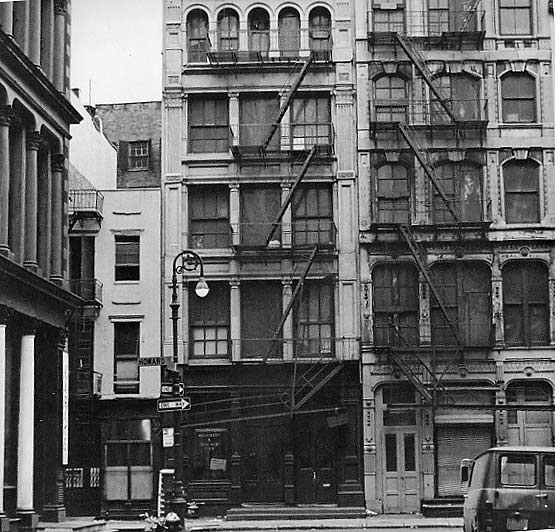
27-29 Howard Street at Crosby Street, early 1970s. Margot Gayle, Cast-Iron Architecture in New York, Dover 1974
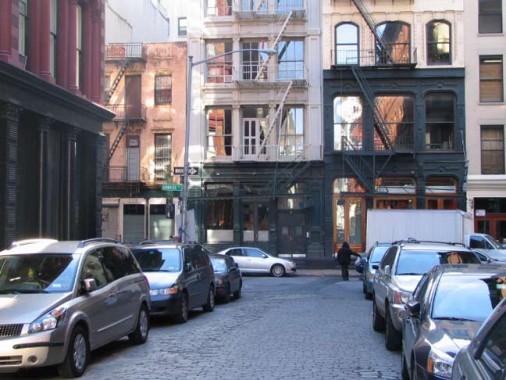
Crosby Street looking south toward Howard. Perhaps it’s the black and white photography but things looked considerably shabbier in the Super Seventies, in Soho, at least. Soho experienced a renaissance beginning with a trickle in the1980s and contuinuing in the 1990s as money poured in and the region became affluent. In this case, it makes your webmaster at least sanguine, because, following the1970 defeat of the Lower Manhattan Expressway (the LoMEX), which would have butchered Broome Street, the amazing cast-iron fronts that defined the neighborhood have been saved for good. Nothing is permanent but these rare and unique buildings will grace Soho and parts of Tribeca for decades and perhaps centuries to come.
27 (left) and 29 were built in 1868 and 1888 — 20 years apart. 29 was built by James Renwick Jr.’s form, Renwick & Sands.
It is interesting to note that architects of this period lavished originality and care on small commercial buildings as well as on large commissions. For example, the year after doing this building, Renwick & Sands won accolades for heir prestigious Second Empire style Booth Theater, 23rd Street and 6th Avenue. —Margot Gayle, Cast-Iron Architecture in New York [demolished in 1975].
NE corner Howard and Crosby Street; Putnam & Co., rolling ladders, 32 Howard Street
Crosby, too, is one of those NYC streets that gets somewhat overlooked, since it’s wedged between main N-S thoroughfares Broadway and Lafayette Street. It has had a checkered history that saw only one-half of it given landmark protection. In recent years, like the rest of Soho, it has become home to a number of high-end residences; homeowners here appreciate its relative quiet. At 126, its northern end near East Houston Street you will find the Housing Works Used Book Café, where all profits go a nonprofit offering housing, health care, job placement and other services for homeless suffering with HIV and AIDS.
Midblock street endings are relatively rare in NYC. Howard Street offers two such views at Mercer , where Howard begins, Crosby (seen above, where it ends at Howard) and here, where Howard meets its eastern end at Lafayette. The building see at left, with its pagoda-like decoration, extends all the way to Canal Street a block to the south, where it fronts.
12/2/07

